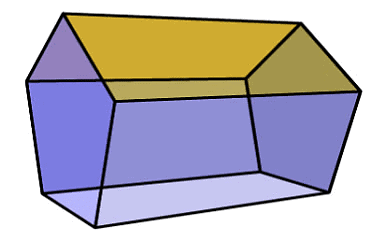Recognise and describe 3D shapes | Year 4 Mathematics PDF Download
| Table of contents |

|
| Properties of 3D Shapes |

|
| Types of 3D Shapes |

|
| Prisms |

|
| How to describe 2D shapes |

|
| How to describe 3D shapes |

|
Properties of 3D Shapes
3D shapes have three dimensions - length, width and depth. 3D shapes have different properties:

- Faces: Faces are flat surfaces on a 3D shape. For instance, a cube comprises 6 faces.
- Edges: Edges are where two faces meet. A cube, for example, has 12 edges.
- Vertices: Vertices are corners where edges meet. In the case of a cube, it has 8 vertices.
Types of 3D Shapes
Let's explore some common 3D shapes and their characteristics:
Sphere

A sphere is a three-dimensional shape that is perfectly round like a ball.
A sphere has:
- 1 curved face
- No vertices
- No edges
Cube
 A cube is a three-dimensional shape with equal sides and angles.A cube has:
A cube is a three-dimensional shape with equal sides and angles.A cube has:
- 6 faces (all shaped like squares)
- 12 edges
- 8 vertices
Cuboid
 A cuboid is a three-dimensional shape that resembles a box or a rectangular prism.A cuboid has:
A cuboid is a three-dimensional shape that resembles a box or a rectangular prism.A cuboid has:
- 6 faces (all rectangular, or a mix of rectangles and squares)
- 12 edges
- 8 vertices
Square-based Pyramid

A square-based pyramid resembles the pyramids in Egypt, featuring a square face at the bottom.
- 5 faces: 1 square and 4 triangular
- 8 edges
- 5 vertices
Cone
 Cones are seen in shapes like ice cream cones, traffic cones, and birthday hats.
Cones are seen in shapes like ice cream cones, traffic cones, and birthday hats.
- 2 faces: 1 circular at the base and 1 curved
- 1 edge around the base
- 1 vertex
Cylinder

Cylinders resemble tubes and toilet rolls in shape.
- 3 faces: 2 circular and 1 curved
- 2 edges
- 0 vertices
Tetrahedron

A tetrahedron is a triangular-based pyramid with the following characteristics:
- 4 faces, all of which are triangular
- 6 edges
- 4 vertices
Triangular Prism
 Another interesting shape is the triangular prism, which includes:
Another interesting shape is the triangular prism, which includes:
- 5 faces (2 triangular and 3 rectangular)
- 9 edges
- 6 vertices
Prisms

- Prisms are characterized by having two ends that are the same shape and size.
- They maintain the same cross-section throughout their length.
- Cutting through a prism at any point reveals the same 2D shape as at either end.
How to describe 2D shapes
When describing 2D shapes, we look at various aspects such as their sides, angles, and symmetry.
Let's delve into the characteristics of 2D shapes:
- Sides: 2D shapes can have sides that are equal in length and some may run parallel to each other.
- Angles: The angles in 2D shapes can vary. They could be right angles, greater than right angles, or less than right angles, providing diversity in their configurations.
- Symmetry: 2D shapes may exhibit different types of symmetry. They can possess line symmetry, rotation symmetry, or even both types of symmetries in some cases.

How to describe 3D shapes
- Three-dimensional shapes are characterized by their faces, edges, and vertices.
- The faces of a 3D shape can be uniform or varied, and a 3D shape may include both curved surfaces and flat faces.

Examples
Example 1: Mika draws a shape with 5 equal sides and 5 equal angles. What is her shape?
Sol:  A shape with 5 equal sides and 5 equal angles is a pentagon.
A shape with 5 equal sides and 5 equal angles is a pentagon.
Example 2: Dawn describes a 2D shape as having 4 right angles. What shape could it be?
Sol: A square has 4 right angles and 4 equal sides.
A rectangle has 4 right angles, but not equal sides.
Dawn’s shape could be a square or a rectangle.
|
69 videos|70 docs|11 tests
|

|
Explore Courses for Year 4 exam
|

|
















